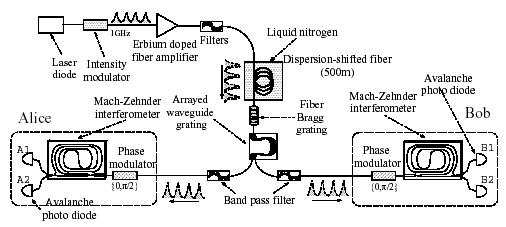Toshimori Honjo1,
Hiroki Takesue1, and Kyo Inoue2
1Optical Science Laboratory, 2Osaka University/NTT Research Professor
Figure 1 shows the experimental setup. A 1-GHz pulse stream amplified by an erbium-doped fiber amplifier (EDFA) was launched into a 500-m DSF. The DSF was cooled with liquid nitrogen to suppress noise photons through the spontaneous Raman scattering process. A series of time-correlated entangled photon pairs was generated in the DSF by the spontaneous four-wave mixing process[2]. After suppressing residual pump, the photons were input into an arrayed waveguide grating (AWG) that separated the signal and idler photons. The signal and idler photons were sent to Alice and Bob, respectively. Alice and Bob randomly imposed phase-modulation on the incoming pulses by 0 or π/2, and then launched them into 1-bit delay planar lightwave circuit (PLC) Mach-Zehnder interferometers. Setting the phase difference between the two arms to 0 and focusing on a certain time slot, they can obtain the following correlation
where θa and θb represents the differential phases imposed by Alice and Bob, respectively, |wn〉 represents the state that a photon goes to detector n placed at the output of each PLC Mach-Zehnder interferometer at site w, with w=A(Alice)or B(Bob). After the photon transmission, Alice and Bob disclosed the photon detection time and the differential phase imposed on corresponding pulses through a public channel. In cases that Alice and Bob detected photons at an identical time slot, they created a key bit using the above correlations.
With this setup, we generated sifted keys with a quantum bit error rate of 8.3 % and a sifted key generation rate of 0.3 bit /sec[3]. We revealed the feasibility of this QKD scheme, and showed the first step toward sophisticated quantum communications.
[1] K. Inoue, Phys. Rev. A 71 (2005) 032301.
[2] H. Takesue and K. Inoue, Opt. Express 13 (2005) 7832.
[3] T. Honjo, H. Takesue, and K. Inoue, Opt. Lett. 32 (2007) 1165.
 |
| Fig. 1. Experimental setup. |